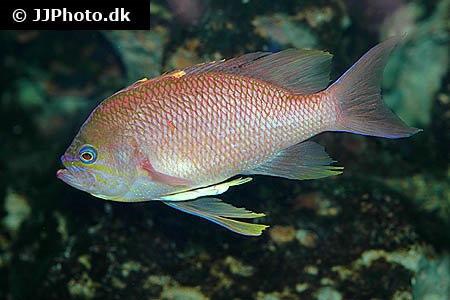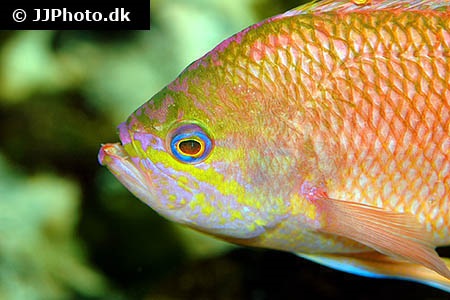Anthias anthias
| Latin name | Anthias anthias |
|---|---|
| Local name | Swallowtail seaperch |
| Family | Serranidae - Anthias |
| Origin | Mediterranean Sea |
| Max length | 27 cm (10.6") |
| Minimum volume |
500 l (132 gal) |
|---|---|
| Hardiness |
Unknown |
| Suitable for aquarium |
Suitable for special aquariums |
| Reef safe |
Always reef safe |
| Aggressiveness | Might be aggressive towards similar species of same gender |
| Recommended |
Small crustaceans (Krill, mysis, artemia...) Zooplankton (Cyclops, pods...) |
|---|
This species lives in cooler water than is the norm for a saltwater aquarium.
The temperature should be kept between 16 and 22 °C (60 and 70 °F).
This fish requires feeding several times a day, especially when newly added.
When the fish can find its natural food in the aquarium it requires less frequent feeding.
In the beginning these fish can have problems eating frozen foods.
Food like Cyclops and Artemia is a good start when the fish are first introduced into the aquarium.
They will however over time learn to eat fish flakes.
Anthias can reside in a group with one male and multiple females if the aquarium is large enough, however, some of the group maywell die, if one buys too many.
If there is a lack of space, it will be the fish lowest in the hierarchy that will die, due to stress and lack of food.
It is best to have only one or a couple in smaller aquariums.
If one wises to have a shoal, it would be wise to keep 8 or more, so that potential aggression will be taken out on multiple specimens.
The following species are best suited for an Anthias shoal:
N. carberryi, P. dispar, P. hawaiiensis, P. ignitus, P. lori, P. pasculus, P. pulcherrimus, P. randalli, P. smithvanizi and P. ventralis.
When a larger number is kept, they will require more space than indicated above.
The Sea Bass family (Serranidae) spans a broad spectrum with regards to how suitable they are to aquaria, as some are best suited to specialist or larger aquaria, while other are often seen in reef aquaria.
Below are described the five subfamilies one sees most often in aquaria. There are however other species one can also keep under the right circumstances, but these are for the most, large predatory fish.
Anthias (Anthiinae)
The Anthias species spans over many different genera, but the most common is the Pseudanthias genus. They mostly have an attractive orange or pink shade.
They are generally all reef safe and peaceful.
There is however a large difference to their food requirements, some species demand constant feeding, whereas others can get used to being fed once a day.
The easiest species are the following: P. bartelettorum, Anthias, Luzonichthys, Nemanthias, Odontanthias, Pseudanthias, Sacura and Serranocirrhitus
Liopropomatinae
This subfamily encompasses some of the smallest fish in the Serranidae family, they can be very colourful but shy. The Liopropoma genus encompasses many species which are suitable for aquaria, however they normally thrive best in a very peaceful- or nano aquarium.
Grouper (Epinephelinae)
These fish grow typically too large for most home aquaria. There are however some species that do lend themselves to the slightly bigger domestic aquarium. Several of the species look very impressive and often have a interesting personality, and they often recognize the aquarist and will become tame over time.
Groupers are predatory fish and eat everything they can swallow; fish, crabs, shrimps and sometimes other invertebrates. Like most large predatory fish they excrete a lot of nutrients to the water, so one therefore needs a good filter system.
Groupers include among others the following genera: Aethaloperca, Cephalopholis, Chromileptes, Epinephelus, Paranthias and Pogonoperca
Soapfishes (Grammistinae)
These fish are like the Groupers predatory fish, but they do not typically, grow so large. They are relatively hardy, but some of the species demand a thorough preperation if one wants to be successful.
Soapfishes are generally very shy and will often hide under an overhang during the day, and hunt at night.
Soapfishes include among others the genera: Grammistes
Serraninae
The most common genera in captivity is Dwarf Seabasses (Serranus) and Hamlets (Hypoplectrus).
See the description of the individual genera below.
Henry C. Schultz. 2006. Anthias Imposters! - The Genus Pseudanthias, Part I, Part II - Reefkeeping Magazine - (English)
Scott W. Michael. 2001. Reef Fishes volume 1 - TFH Publications / Microcosm Ltd. - (English)
Bob Fenner. Fancy Sea Basses, The Anthiinae, Part I, Part II - Wet Web Media - (English)
Bob Fenner. The Basses, Family Serranidae - Wet Web Media - (English)




